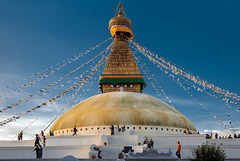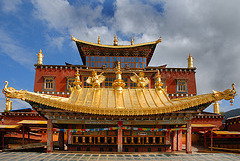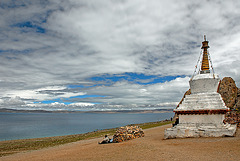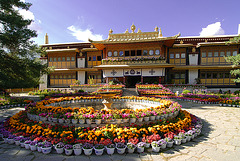
Tibet, its landscape and its culture
In this set I post my captures from different journeys to Tibet, Yunnan and Nepal as long as the Tibetan culture is spread out to many neighbor countries.
May 2004 was my first visit in Tibet travelling from Lhasa to the Lake Manasarovar and the Holy Mountain Kailash and to go round it called the Holy Kora.
August 2007 was my second visit in Tibet, coming to Lhasa, visiting the great and high sal… (read more)
May 2004 was my first visit in Tibet travelling from Lhasa to the Lake Manasarovar and the Holy Mountain Kailash and to go round it called the Holy Kora.
August 2007 was my second visit in Tibet, coming to Lhasa, visiting the great and high sal… (read more)
Bodnath Kathmandu Nepal is one of Tibetan souls
| |
|
|
|
Bodnath isn't located in Tibet, but its Tibetan culture
Bodnath, also called Boudhanath or Baudhanath or the Khāsa Caitya is one of the holiest Buddhist sites in the area of Kathmandu, Nepal. It is known as Khāsti by Newars as Bauddha or Bodh-nāth by modern speakers of Nepali. It is located about 11 km from the centre of Kathmandu, Nepal on the northeastern outskirts of the city. Its platform is a massive mandala and it is the largest spherical stupa in Nepal.
The Buddhist stupa of Boudhanath dominates the skyline. The ancient Stupa is one of the largest in the world. The influx of large populations of Tibetan refugees from China has seen the construction of over 50 Tibetan Gompas (Monasteries) around Boudhanath. Boudhanath is one of the sites in Nepal listed as UNESCO World Heritage Sites. Along with Swayambhunath, to the western side of the city centre, it is one of the most popular tourist sites in Kathmandu city.
The Stupa is on the ancient trade route from Tibet which enters the Kathmandu Valley by the village of Sankhu in the northeast corner, passes by Boudnath Stupa to the ancient and smaller stupa of Cā-bahī (often called 'Little Boudnath'). It then turns directly south, heading over the Bagmati river to Patan - thus bypassing the main city of Kathmandu (which was a later foundation). Tibetan merchants have rested and offered prayers here for many centuries. When refugees entered Nepal from Tibet in the 1950s, many decided to live around Bouddhanath. The Stupa is said to entomb the remains of a Kasyapa sage venerable both to Buddhists and Hindus.
Zhongdian Songzanlin Monastery
| |
|
|
|
In 1679, Dalailama chose this place by divination, and it went on to become the uppermost public place in Yunnan which features the particular local characteristics. Annually, the Gedong Festival is celebrated here by the Tibetans. Pious believers, with their knees and foreheads knocking the ground at every step, come here to pray.
Actually Zhongdian and this monastery is located in the formaly eastside of Tibet, now in the province Yunnan.
Lhasa monks debating inside the Sera Monastery
| |
|
|
As a part of their study, lamas must participate in debates to further their comprehension and proceed to more advanced levels of study. The debating traditions in the Sera Monastery are unique among the three famous monasteries in Lhasa. Debates are conducted by the lamas in the monastery every day beginning at 3.a.m. In a battle of words, they supplement their efforts by using a variety of gestures including clapping their hands, pushing their partners for an answer, or plucking their prayer beads to win the virtue of the Buddha.
Stupa at the Namtso Lake Tibet
| |
|
|
|
Namtso Lake in the Tibet Autonomous Region was selected as one of the five most beautiful lakes in China by Chinese National Geography magazine. Namtso Lake's touching beauty should not be missed by any traveler who visits Tibet. Its purity and solemnness are symbols of Qinghai-Tibet Platean. In Tibetan, Namtso means 'Heavenly Lake.' It is considered one of the three holy lakes in Tibet. Namtso is famous for its high altitude (4718 meters), vast area (1961 square kilometers) and beautiful scenery.
Being the second largest saltwater lake in China only after Qinghai Lake, Namtso is the biggest lake throughout Tibet. Meanwhile, it is the highest altitude saltwater lake in the world. The water here is a storybook crystal-clear blue. Clear skies join the surface of the lake in the distance, creating an integrated, scenic vista. Soul of every visitor who has ever been here seems to be cleansed by the pure lake water.
Namtso Lake maintains its levels from rainfall and melted snow flowing from high mountains. Five islands stand in the waters of the lake, among which the largest one is Liangduo island. In addition another five bylands stretch into the lake from different directions. Zhaxi byland is the largest in area of these five. A great many bizarre stone peaks can be found on this byland. Some of them are like trunks; some look like human beings; some resemble trees. Various kinds of vivid shapes can easily arouse your imagination. At the same time there are many quiet grottos which are masterpieces of nature. Some grottos are narrow and long like subways; some are full of stalactites; still, others are like louvers. Queer rocks, steep peaks, natural stone ladders and other landform wonders on Zhaxi byland present visitors a picture filled with mystery and enchantment.
Yak bull nearby the Namtso Lake Tibet
| |
|
|
Summer is the best time for Namtso Lake. Wild yaks, hares and other wild animals leisurely look for food along the expansive lake shores; countless migratory birds fly here to lay eggs and feed their young; sometimes lovely fishes in the lake jump out of the lake water, enjoying the warmth of the sunshine; sheep and cows herds are like flowing white blanks on the green grassland which can stretch as far as your eyes can see; the dulcet songs of Gauchos resound through the valleys. This time of the year Namtso Lake is full of life and activity. Therefore it is no wonder Tibetans take Namtso Lake the symbol of goodliness and happiness. Really Namtso Lake is a blessing from nature.
Barkhor Square in front of the Jokhang Monastery
| |
|
|
Barkhor Square, the approach to the complex taken by most tourists today.
The sky shows a dramatic spectacle.
It is a large plaza built in 1985. The clockwise barkhor circumambulation is close to Johkang Temple, which is a permanent stea. There are totally four sangkangs (a stone building with a shape of pot-belly) in the Jokhang: behind the first two there are two joined enclosures, the other two are regarded as the rear of the Jokhang.
Lhasa Norbulingka Summer Palace
| |
|
|
Norbulingka, meaning 'Treasure Park' in Tibetan, is situated in the western suburb of Lhasa City, at the bank of the Kyichu River, about one km southwest of Potala Palace. The garden covers an area of 360,000 square meters, with 374 rooms inside. It is the biggest man-made gardens in Tibet Autonomous Region.
Construction began in the 1740s. The area used to be wasteland with wild animals, weeds and scrub which the Seventh Dalai Lama liked and often visited, and, as a result, the Qing magistrate had a palace built. Years later, Kelsang Potrang was built by order of the Seventh Dalai Lama. Later it was used as the Summer Palace for successive Lamas, where they solved the political problems and held festive celebrations. After a series of expansions and renovations, the appearance was improved with potrangs, pavilions, gardens and woods. It has now been turned into a park open to the public.
Lhasa and the Potala
| |
|
|
|
The Potala Palace rises a further 170 meters and is the greatest monumental structure in all of Tibet. Early legends concerning the rocky hill tell of a sacred cave, considered to be the dwelling place of the Bodhisattva Chenresi (Avilokiteshvara), that was used as a meditation retreat by Emperor Songtsen Gampo in the seventh century AD. In 637 Songtsen Gampo built a palace on the hill. This structure stood until the seventeenth century, when it was incorporated into the foundations of the greater buildings still standing today. Construction of the present palace began in 1645 during the reign of the fifth Dalai Lama and by 1648 the Potrang Karpo, or White Palace, was completed. The Potrang Marpo, or Red Palace, was added between 1690 and 1694; its construction required the labors of more than 7000 workers and 1500 artists and craftsman. In 1922 the 13th Dalai Lama renovated many chapels and assembly halls in the White Palace and added two stories to the Red Palace. The Potala Palace was only slightly damaged during the Tibetan uprising against the invading Chinese in 1959. Unlike most other Tibetan religious structures, it was not sacked by the Red Guards during the 1960s and 1970s, apparently through the personal intervention of Chou En Lai. As a result, all the chapels and their artifacts are very well preserved.
The Holy Kailash in Tibet
| |
|
|
|
Start the Kora around the Kailash (the Kora is the holy way around the mountain)
Barely a century ago, Mt. Kailash (6,658m) was shrouded in mystery. This holiest of sacred mountains was once only a myth to the outside world. Assumed to lie somewhere between the vast expanse of China and the subcontinent of India, it lay hidden within the forbidden land of Tibet. To the Tibetans it is Gangkar Ti se or Gang Rimpoche (Precious Snow Mountain) and is revered not only by Buddhists but also by millions of Hindus, Jains and followers of other traditional faiths.
The mountain is out of consideration for its religious meaning so far
not climed yet. First permission for mounting to the summit was given to Reinhold
Messner (1985), which he requested a permission for the surrounding area. This
done however without the execution. Since then no further permission
was given, also not in the year 2001, as the Spaniards Jesús Martinez
Novaz has planned an expedition for "political demonstration against
environmental degradation and for larger, global consciousness"
defined. This led however to world-wide protests of different groups
of religions, which, supported from famous mountain climbers, reject a
mounting of the Kailash.
Thank you Reinhold Messner for your consideration to all the people who believe in this holiness of the great jewel mountain!
Tibetan boys in the village
| |
|
The boys enjoyed getting pencil and pen for their school. Although the location of this village was in Tibetan territory before, the influence of the Chinese is fixed for the future.
Songzanlin Monastery
| |
|
The monastery is full of treasures. There are a lot of golden figures of Buddha josses, golden lamps, Tibetan lections, silver censers and so on. All of these are wonderful collections accumulated from each dynasty. They are precious productions made by people of both Tibet nationality and Han nationality.
Landscape on the way to Zhongdian
| |
|
|
|
This part was the most south eastern Tibet territory before and is now belong to the Yunnan province in China. The landscape still keeps its beauty.
Tibetan woman in a village near Zhongdian
| |
|
|
|
View to the Songzanlin Monastery complex
Wall paintings inside the Songzanlin Monastery
| |
|
|
it was unbeliveable that inside the monastery we discovered two oversized pictures of the Highnes The 14th Dalaih Lama and many pilgrims took meditation and respect gestures in front of the images. An other picture shows the last Punchen Lama who also is banned and a taboo in China. The Holy leaders of Tibet cannot be banned - and never in Tibet! (It wasn't possible to take a photo inside the monastery)
Ganden Monastery near Lhasa
| |
|
Monks return back to Ganden Monastery.
The Monastery is located on Wangbur Mountain, on the southern bank of Lhasa River in Tagtse County, 47 kilometers (29 miles) from Lhasa City. It stands at an altitude of 3,800 meters (12,467 feet) above sea level! Ganden Monastery is one of the earliest and largest Buddhist monasteries in Tibet, and stands atop of the six famous temples of Gelugpa - a branch of Tibetan Buddhism. Its significance as a religious, artistic, political and cultural relic led to it being preserved by the National Key Cultural Relic Preservation scheme in 1961, and is now known as being one of the 'Three Great Temples'.
At the rooftop of the Potala Palace
| |
|
|
|
I came to the Potala the second time two years later in Aug. 2007. It isn't allowed anymore to climb to Potalas rooftop, this capture is unique.
Pilgrims step in the Toling Monastery
| |
|
the Toling Monastery in Western Tibet was destroyed completly during the Chinese invasion and rebuilt during the last ten years for the program to reset the Tibetian culture (in the Chinese way)
Jump to top
RSS feed- Latest items - Subscribe to the latest items added to this album
- ipernity © 2007-2024
- Help & Contact
|
Club news
|
About ipernity
|
History |
ipernity Club & Prices |
Guide of good conduct
Donate | Group guidelines | Privacy policy | Terms of use | Statutes | In memoria -
Facebook
Twitter


















